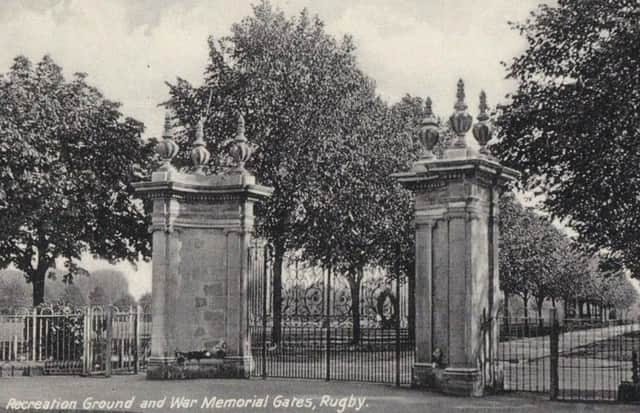LOOKING BACK - November 1, 2018 edition


Christine Hancock, Projects Co-ordinator at Rugby Family History Group has written this week’s column and hopes readers may be able to help. Please get in touch.
Back in 2014 Rugby Family History had been in existence for 40 years. How should we celebrate this anniversary? We quickly realised that it was also a significant centenary of an even more important event, the start of the First World War. We are a family history group, and everyone has a relative who lived through, took part in and sometimes died in this “War To End All Wars”.
Advertisement
Hide AdAdvertisement
Hide AdWe would start a new project to mark our anniversary, but what? A list of all the War Memorials in the area? The dead are remembered on the memorials, what about the men who fought and survived? It had to be something that all the members of the group could take part in. We soon discovered the difficulties of researching men who survived. How do you do it? Where do you start? There is no definitive list.
We finally decided on something we thought would be easier. The town of Rugby has a war memorial; the gates in Hillmorton Road, which lists all the men from Rugby who died in both World Wars. We would concentrate on the 423 names of WW1. We would research each man, discover his life before he served, the family history part: When and where he was born? Who were his parents? Did he marry, have children? What was his occupation? Then we would find out about his military career. When did he join the forces? Which battles did he take part in? How did he die and where was he buried?
What to do with all this information? We set up a blog https://rugbyremembers.wordpress.com/ and to spread the work over the whole period of the war, have published each biography on the centenary of that man’s death. Our first problem was deciding exactly who these men were. The memorial gates provide a list with just surname and initials. There are no forenames, no regiment in which they served, no date of death. Most were obvious, a search of the Commonwealth War Graves Commission produced a candidate, some were more difficult.
We started going through the pages of the contemporary Rugby Advertiser and set up a name index for everyone mentioned. Someone volunteered to transcribe the pages (not the whole newspaper, just articles connected with the war). We added the most interesting to the blog, so there is now a weekly report of what was happening in Rugby. We searched other local war memorials and listed the names on our main website. https://www.rugbyfhg.co.uk/war-memorials Sometimes a man appeared on more than one memorial. For example, as well as the gates, they might appear on the New Bilton WM or a grave in Clifton Road Cemetery, as well as the BTH WM or a church plaque.
Advertisement
Hide AdAdvertisement
Hide AdOur members picked names from the list, did the research, wrote a biography and it was added to the Blog. We are now nearing the end of the project. There is a little more to do; the last Rugby man did not die until mid-1919. We have discovered some amazing and heart-rending stories; some families lost more than one son, a couple lost three.
Men did not just die in the mud and trenches of western France There was Gallipoli and Palestine and the mountains of Italy and Greece. There were the men in ships, navy and troop transports, blown up or drowned. Then there were the pilots of what became, in 1918, the RAF; although most of them seemed to have died in accidents rather than by enemy fire. And of course, we mustn’t forget the drivers of ambulances or the men who looked after the horses. Our Rugby men were everywhere.
I mentioned that we had difficulties. It is with this that I hope your readers can help. There is a small group of names that we have been unable to trace. Rugby was an expanding town at the time, people moved to the factories from elsewhere, many of them after the 1911 census, where we can usually find our men. Sometimes it is a common name that is impossible to distinguish from others. Sometimes there is a name that seems to have never existed in Rugby or the surrounding area. There are even a few where the only possible candidate did not actually die but survived for many years afterwards.
Does anyone recognise these names?
ALLARD, H. E.
CLEMENTS, E. C.
FERGUSON, B.
INWOOD, J.
REYNOLDS, G.
(there are eight Reynolds names on the gates. G.E Reynolds is George Ellis, but who is G Reynolds? Was there a mistake with the list?)
RIVERS, A.
ROBERTS, R.
SALMON, R. J.
Advertisement
Hide AdAdvertisement
Hide Ad(We have found J.R A (John Robert Albert) Salmon. Did a second relative add the same person and got the initials wrong?)
TURNAM, P.H.
THOMPSON, A.
(There are four Thompsons on the gates, one of them L. Thompson, but there are two men who died: Leonard and Levi. Is the unidentified A. Thompson one of these and they got the name wrong? Or is it the Arthur Thompson who worked in the Willans and Robinson Drawing Office? We know he enlisted in Rugby on 4th September 1914, but cannot locate anything more.)
Please help us find them. We do not want them to be forgotten.
Christine Hancock
(Projects Coordinator, Rugby Family History Group)
Note: John Frearson who researched and wrote several biographies for the RugbyRemembers project, will be giving a talk “Rugby at War” at The Merchants, on 6th November 2018 as part of their Festival of Remembrance Beer Festival.